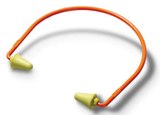 Have you ever heard a slight ringing in your ears, maybe after mowing, shooting, or attending a concert? That is the first sign that you may have damaged your hearing, or are about to – hopefully it is just limited to the ringing sound, and is not permanent. Unfortunately for me, I fall into the latter category, which is one reason I do not like crowded or noisy places – it is nearly impossible for me to hear others with all the background noise.
Have you ever heard a slight ringing in your ears, maybe after mowing, shooting, or attending a concert? That is the first sign that you may have damaged your hearing, or are about to – hopefully it is just limited to the ringing sound, and is not permanent. Unfortunately for me, I fall into the latter category, which is one reason I do not like crowded or noisy places – it is nearly impossible for me to hear others with all the background noise.
How loud is too loud:

As you can see by the chart above, noise ranging from 85 to 88 dB (decibels – a measure to rate how “loud” something is) can start causing hearing issues after 8 hours. The catch is that for every 3 dB increase, the amount of time till you may experience is halved – thus @ 88 – 91 it now only takes 4 hours, 91 to 94 only takes 2 hours, etc… Oh and there is one other catch – it is cumulative, so going from a noisy factory, driving home through traffic, and then mowing the grass all adds up.
Some common dB levels around the house:
- 10 dB Normal breathing
- 10-20 dB Rustling leaves
- 20-30 dB Whispering to one another
- 30-40 dB Stream, Fountain, Babbling Brook
- 50-65 dB Normal conversation
- 70-80 dB Household appliances, hairdryers, etc… (Annoying but not theoretically damaging)
- 85-105 dB Lawnmowers, leaf blowers, gas powered tools
- 95-105 dB Farm tractor, Snowmobile, Jet Ski
- 110+ dB Jackhammer, power saw, chain saw
- 130-140 dB Shooting a Shotgun, Rifle, or Pistol
Protect your hearing:
 While working with any power tools, nailing, or just mowing the grass you should wear hearing protection. The choices here are endless & range from disposable foam earplugs, to high-end Auto Noise Reducing earmuffs. Currently, I have been using the product shown above which complies with ANSI S3.19-1974. It has a NRR (Noise Reduction Rating) of 28 db, which reduces the 110 dB items down to a safe 82 dB level, and still allows me to hear someone trying to get my attention.
While working with any power tools, nailing, or just mowing the grass you should wear hearing protection. The choices here are endless & range from disposable foam earplugs, to high-end Auto Noise Reducing earmuffs. Currently, I have been using the product shown above which complies with ANSI S3.19-1974. It has a NRR (Noise Reduction Rating) of 28 db, which reduces the 110 dB items down to a safe 82 dB level, and still allows me to hear someone trying to get my attention.
Proper Care & Maintenance:
- Wipe earmuffs with a damp cloth after each use, store them in a safe place, and replace cushions when they lose their resilience.
- Wash reusable earplugs every day, store them in a clean case, and replace if plugs are hard or discolored.
- Wipe canal caps (headband plugs) with a damp cloth after each use, store them in a safe place so the headband will not be bent or twisted, and replace if the band is damaged and/or no longer fits comfortably.
Additional Info & Web Sites
Tool Box Talk by Specific Trade from University of Washington
OSHA Hearing Selector
OSHA Standards 29 CFR 1910.095
NIOSH / CDC Hearing Protection Guide & Resources

Great posting, Sean! The key take-away for me is the need to match protection to activity, via the db/duration chart you provided. It’s interesting to me that the median db level in the “Lawnmower/Leafblower” portion of the chart (about 95 db) corresponds to about 30 mins to one hour’s worth of activity for damage to occur, which is just about the same amount of time many of us spend mowing a lawn or cleaning up with a leafblower. I don’t think I’ve ever used hearing protection in these particular activities. But I will from now on.
Great posting, Sean! The key take-away for me is the need to match protection to activity, via the db/duration chart you provided. It’s interesting to me that the median db level in the “Lawnmower/Leafblower” portion of the chart (about 95 db) corresponds to about 30 mins to one hour’s worth of activity for damage to occur, which is just about the same amount of time many of us spend mowing a lawn or cleaning up with a leafblower. I don’t think I’ve ever used hearing protection in these particular activities. But I will from now on.